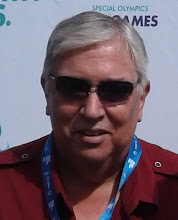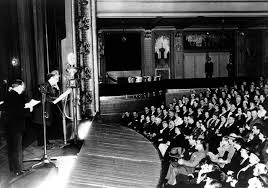Two Stars Are Born: The Way It Was, 5 May
One of old-time radio's grand (if controversial) old men, and one of its favourite ladies, share a birthday today.
1899: WHO'S REGUSTED?---One half of old-time radio's first major star performing and writing duo is born in Richmond, Virginia.
To his parents he is born Freeman Gosden; to the first generations of serious radio fans, he is the first half, the practical yet caustically repressed half, of Amos 'n' Andy, born nine years following the birth (in Peoria) of his future partner in mike and pen, Charles Correll, whom he meets and first befriends in North Carolina.
While minstrel-style wordplay humor was common in the formative years of the program, it was used less often as the series developed, giving way to a more sophisticated approach to characterization. Correll and Gosden were fascinated by human nature, and their approach to both comedy and drama drew from their observations of the traits and motivations that drive the actions of all people: while often overlapping popular stereotypes of African-Americans, there was at the same time a universality to their characters which transcended race.Central to the program was the tension between the lead characters. Amos stood as an "Everyman" figure: a sympathetic, occasionally heroic individual who combined practical intelligence and a gritty determination to succeed with deep compassion---along with a caustic sense of humor and a tendency to repress his anger until it suddenly exploded. Andy, by contrast, was a pretentious braggart---obsessed with the symbols of success but unwilling to put forth the effort required to earn them. While Andy's overweening vanity proved his greatest weakness, he was at heart a poignant, vulnerable character---his bombast masking deep insecurity and a desperate need for approval and affection. The Kingfish was presented as a shrewd, resourceful man who might have succeeded in any career, had he applied himself---but he preferred the freedom of living by his wits. Other characters displayed a broad range of human foibles---the rigid, hard-working Brother Crawford, the social climber Henry Van Porter, the arrogant Frederick Montgomery Gwindell, the slow-moving but honest Lightning, the flamboyant Madam Queen. And still other characters stood as bold repudiations of stereotypes---the graceful, college-educated Ruby Taylor and her quietly dignified father, the self-made millionaire Roland Weber, the capable and effective lawyers and doctors and bankers who advised Amos and Andy in times of crisis. Beneath the dialect and racial imagery, the series celebrated the virtues of friendship, persistence, hard work, and common sense , and as the years passed and the characterizations were refined, Amos 'n' Andy achieved an emotional depth rivaled by few other radio programs of the 1930s.Above all, Correll and Gosden were gifted dramatists. Their plots flowed gradually from one into the next, with minor subplots building in importance until they took over the narrative, before receding to give way to the next major sequence, and seeds for future storylines were often planted months in advance. It was this complex method of story construction that kept the program fresh, and enabled Correll and Gosden to keep their audience in a constant state of suspense. The technique they developed for radio from that of the narrative comic strip endures to the present day as the standard method of storytelling in serial drama. Storylines in Amos 'n' Andy usually revolved around themes of money and romance---Amos's s progress toward the goal of marrying his beloved Ruby Taylor stood in contrast to Andy's romantic fumblings, as the daily challenge of making ends meet formed a constant backdrop. The taxicab company remained the foundation of Amos and Andy's enterprises, but the partners constantly explored other ventures, including a lunchroom, a hotel, a grocery, a filling station, and a 500-acre housing development. Andy invariably claimed the executive titles, while Amos shouldered the majority of the work---until Amos's temper finally blazed and Andy was forced to carry his share of the load.. . .Whatever the show's artistic merits and national popularity, its premise divided blacks, especially black newspapers. As early as 1931, a group of black attorneys tried to get an injunction to have it taken off the air at the same time that a Harlem fund-raiser sent Gosden and Correll a telegram thanking them "for being friends of the Negro race." One called it a terrible example to black youth; another claimed it was one more example of whites' curiosity about the black demimonde. The Pittsburgh Courier, a leading black paper, tried to get the FCC to yank it, accusing it of the "exploitation of Negroes for profit." The black Louisville News editorialised that, while it "yields to none in race pride," it was "unable to work up a sweat over Amos 'n' Andy. The respected Chicago Defender attacked the Courier and invited Gosden and Correll to perform at a picnic for thirty thousand black children.---Gerald Nachman, from "A Voice of Another Colour," in Raised on Radio. (New York: Pantheon Books, 1998.)
1915: "HOLD IT, WONGA!"---A New York police officer and his wife become the proud parents of Alice Jeane Leppert today . . . little imagining she will grow up to charm stage and film audiences with her honey contralto voice ("Six films I made with Don Ameche and, in every one of them, my voice was deeper than the plot") and tart showgirl style, until she softens her style (but not her voice), feuds with 20th Century Fox over a broken promise, and becomes an old-time radio favourite playing the softly acid but loving wife of an addled bandleader/singer/comedian, opposite her real-life bandleader/singer/comedian husband on The Fitch Bandwagon, beginning in 1946. By 1948, their popularity will be acknowledged with a name change . . . to The Phil Harris-Alice Faye Show.
She rose from the mean streets of New York's Hell's Kitchen to become the most famous singing actress in the world. When the pressures of fame became too much, she had the courage to leave Hollywood on her own terms.---From A&E Biography.I don't know what happened to the picture business. I'm sorry I went back to find out. Such a shame.---Alice Faye, after the only film she would make following the end of the Harris-Faye radio program, 1962's State Fair.
AIRWAVES
1945: FREE AT LAST!---Radio Orange brings the Netherlands the news they've been waiting to hear, and from the man who initiated the station's establishment in the first place: Premier Pieter S. Gerbrandy---administering the Dutch government-in-exile, after Queen Wilhelmina removed predecessor Jonkheer Dirk Jan de Geer over the latter's advocacy of co-existence with Nazi Germany and belief the war could never be won---tells the Dutch they've been liberated formally from the Nazi grip.
CHANNEL SURFING . . .
1940: CLOWN HALL TONIGHT (REPRISE)---Performed live from New York's Ritz Carlton Hotel, it's a second and far better arrayed and executed satire of Fred Allen's former Town Hall Tonight mirth-and-musicale, on tonight's edition of The Jell-O Program Starring Jack Benny. (NBC.)
Cast: Mary Livingstone, Dennis Day, Don Wilson. Music: Phil Harris and His Orchestra. Writers: Milt Josefsberg, Sam Perrin, John Tackaberry.
1946: MR. AND MRS. BREAKFAST SHOW---Tallulah Bankhead joins your host in a classic---and deadly---parody of the early-morning husband-and-wife soap-and-sap talk shows beginning to spring up on classic radio, on tonight's edition of The Fred Allen Show. (NBC.)
Claghorn: Kenny Delmar. Titus: Parker Fennelly. Mrs. Nussbaum: Minerva Pious. Openshaw: Alan Reed. Music: Al Goodman and His Orchestra. Writers: Fred Allen, Nat Hiken, possibly Robert Schiller.
1950: VICKI'S BAD INFLUENCE---The Halls take more than umbrage when they learn someone on the college board wants Victoria (Benita Hume Colman) to knock it the hell off encouraging some students who've shown the aptitude to pursue the acting career she once enjoyed, on tonight's edition of The Halls of Ivy. (NBC)
Hall: Ronald Colman. Wellman: Herbert Butterfield. Merriweather: Willard Waterman. Betty: Lucille Norbert. Additional cast: Bea Benaderet, Lois Corbett. Writers: Don Quinn, Nat Wolfe. (Note: This edition includes a performance of the complete version of this show's saccharine but still charming theme song, composed by Henry Russell.)
1950: THE DEACON JONES SQUARE DANCE TROUPE---Connie (Eve Arden) balks at signing up to tutor the children of a touring square dance troupe, until she learns how generously they'll pay for one summer month---and how her favourite square might be rounded up for the gig, too, on tonight's edition of Our Miss Brooks. (AFRS Rebroadcast.)
Boynton: Jeff Chandler. Walter: Richard Crenna. Mrs. Davis: Jane Morgan. Conklin: Gale Gordon. Harriet: Gloria McMillan. Writers: Al Lewis, Joe Quillan.
PREMIERING TODAY . . .
1890---Christopher Morley (author: Information, Please; Hallmark Playhouse; Studio One), Haverford, Pennsylvania.
1912---Bret Morrison (actor: The Shadow; The Adventures of Superman), Chicago.
1914---Tyrone Power (actor: Freedom USA), Cincinnati.
1915---Ben Wright (actor: One Man's Family; Hey, Boy; Have Gun, Will Travel), London.
1912---Bret Morrison (actor: The Shadow; The Adventures of Superman), Chicago.
1914---Tyrone Power (actor: Freedom USA), Cincinnati.
1915---Ben Wright (actor: One Man's Family; Hey, Boy; Have Gun, Will Travel), London.












0 Comments:
Post a Comment
Subscribe to Post Comments [Atom]
<< Home